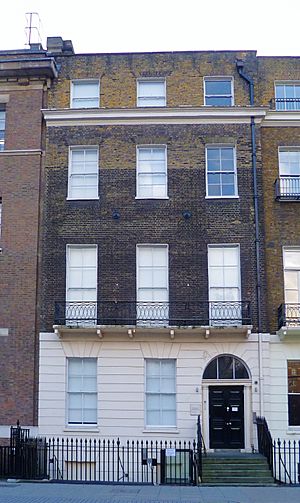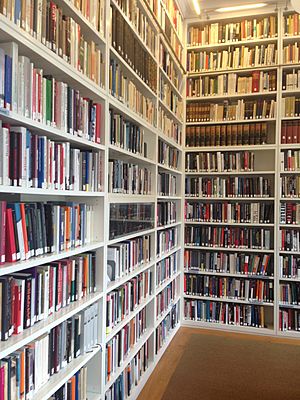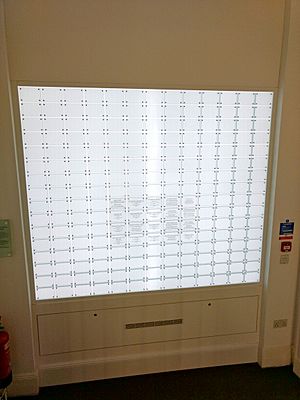Wiener Holocaust Library facts for kids
The Wiener Holocaust Library is the oldest place in the world dedicated to studying the Holocaust. This includes looking at why it happened and what its lasting effects are. The library started in 1933 in Amsterdam as a place to share information. It told Jewish communities and governments around the world about the terrible treatment of Jewish people by the Nazis.
After World War II, it became a research center and a library open to everyone. Today, you can find it in Russell Square, London. In 2017, the library made a special online list of documents from the UN War Crimes Commission. This list helps researchers find important information. The library also holds the UK's digital copy of the International Tracing Service archive. This archive helps people find out what happened to victims of Nazi persecution.
Contents
Discovering the Library's Past
The Wiener Holocaust Library has a long and important history. It began with one man's dedication to collecting information.
How the Library Started
The library was founded by Alfred Wiener, a German Jew. He worked for a Jewish civil rights group and spent years gathering proof of antisemitism, which is hatred towards Jewish people. He collected many items, like books, photos, letters, and even children's games. These items showed how Nazi ideas and racist beliefs were spreading.
In 1933, Alfred Wiener had to leave Germany and moved to Amsterdam. There, he started the Jewish Central Information Office (JCIO). This office collected information about the Nazis. Dr. David Cohen, a well-known Dutch Jew, became its president.
Moving to London
After a terrible event called Kristallnacht in November 1938, Wiener and his archives moved to Britain. This was for safety. Sadly, Wiener's wife and three daughters stayed in the Netherlands. They were later taken by the Nazis to camps.
In January 1945, a rare chance for a prisoner exchange happened. The Wiener family was chosen and sent to Switzerland. Tragically, Alfred's wife, Margarethe, became very ill and passed away shortly after arriving. His daughters, Ruth, Eva, and Mirjam, then traveled to New York. There, they were finally reunited with their father.
The collection officially opened in London on September 1, 1939. This was the same day the Nazis invaded Poland. In London, the Jewish Central Information Office acted like a private intelligence group. Alfred Wiener was even paid by the British government to keep them updated on what was happening in Germany. The Library continued to record the experiences of Jewish people in Europe.
After World War II
After World War II ended, the library used its huge collection of materials about Nazi Germany to help bring war criminals to justice. They provided information to the United Nations War Crimes Commission. People started calling it 'Dr Wiener's Library,' and eventually, that became its official name.
The Library also published a regular bulletin starting in 1946. This publication used many of the library's own unique sources. In the 1950s and 1960s, a very important job was collecting stories from people who had witnessed these events. These eyewitness accounts became a special part of the library's collection.
Challenges and Changes
In 1974, the library faced money problems. It was decided that part of the collection would move to Tel Aviv. During this time, many documents were microfilmed to protect them. The plan to move the whole library was stopped in 1980. However, some books had already been sent, creating a separate Wiener Library at the University of Tel Aviv. The London library kept the microfilmed copies.
Today, The Wiener Holocaust Library is a research library. It focuses on studying the Holocaust, other genocides, Nazi Germany, and the history of Jewish people in Germany. It also documents Antisemitism and Neonazism. It is a registered charity in England. In 2011, the library moved to its current location in Russell Square.
Collections and Learning Programs
The Wiener Holocaust Library has many valuable items and offers great ways to learn.
What the Library Collects
Since 1933, the library has been collecting materials about the Holocaust, its causes, and its effects. Its collection includes:
- About 70,000 books and pamphlets.
- 2,000 collections of physical documents.
- 45,000 photographs.
- 3,000 different magazine and newspaper titles.
- 1 million newspaper clippings.
- Posters, objects, artworks, and digital materials.
- Films and audio recordings.
How the Library Helps You Learn
The library offers many ways for people to learn about its important topics.
Exhibitions
The Wiener Holocaust Library has free public exhibitions. They usually have three temporary exhibitions each year in their ground floor space. They also have smaller displays in the Reading Room, traveling exhibitions, and online exhibitions you can explore from home.
The Holocaust Explained
Since 2015, the library has looked after The Holocaust Explained. This is an educational website designed to help British schoolchildren learn about the Nazi era and the Holocaust. The website is made for students aged 13 to 18, following the British school curriculum. It covers topics from the history of antisemitism to the lasting impact of the Holocaust. It uses the library's unique historical materials to help explain each part.
The Refugee Map
In November 2021, the library relaunched the Refugee Map. This is a "digital map that shows refugee journeys through photos, diaries, letters, and interviews." As of April 2024, the map has hundreds of records, collections, and historical map overlays. It helps you see the paths refugees took.
The Fraenkel Prize
The library also gives out the Fraenkel Prize in Contemporary History. This award was started by Ernst Fraenkel OBE. It is given every year for "outstanding work of twentieth-century history" in areas the library focuses on. These areas include European history, Jewish history, the two World Wars, antisemitism, comparative genocide, and political extremism.
See also
- Austrian Holocaust Memorial Service
- Stephen Roth Institute




